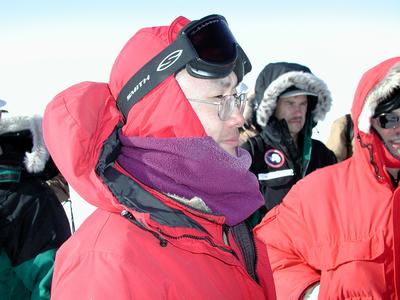15 December, 2001
Walking out to the SPASE shack today was difficult. Due to the intense winds, snow and low clouds made visibility next to nothing. The only way to travel forward was to follow the bamboo flag markers that indicated the path to the Dark Sector.
Once I arrived at the tank, I opened the hatch of the lid to observe how the ice was forming. Since the sun was not visible due to the white conditions, it was difficult to assess the condition of the forming ice. However, on the surface numerous bubbles were apparent. I hope that the bubbles are restricted to the upper layers of the ice, for too many bubbles will make obtaining data difficult.
Inside the SPASE Shack, I worked with Serap on setting up the instrumentation for the detector. In order for the optical modules to operate, a high voltage must be run through them. Determining exactly which voltage to use was the goal of today's work. Too much voltage and the signal would be saturated by noise. Too little voltage and the signal would be too weak to detect.
We started at 900 volts and then took a count of the pulse emitted by each optical module. The pulse rate is measured in Hertz, or number of pulses per second. After recording the data, we raised the voltage and conducted another count. The data we recorded was placed in a graph so we could visually see where the optical modules were operating optimally. This type of work takes time, so we will have to spend a few days at it in order to obtain all of the necessary data.
Biological Data
Saturated Oxygen: 94%
Pulse Rate: 83
Weather Data
Temperature: -25.1 F
Wind Chill: -53.7 F

Serap turning on the high voltage to the optical modules.

Dr. Xinhua Bai, an astroparcticle physist from Bartol Research Institute.
Contact the TEA in the field at
.
If you cannot connect through your browser, copy the
TEA's e-mail address in the "To:" line of
your favorite e-mail package.
|
